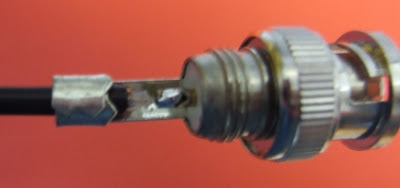When I first got my Elektor LCR meter I didn't have any four wire test leads for it so I made up a pair from the ends of an old VGA monitor cable and some miniature crocodile clips.
These worked well enough for measuring normal components but they are not true Kelvin leads because the wires meet at the crocodile clips, not at the device under test. The steel clips add about 3mΩ and 200nH. True Kelvin clips insulate the two jaws from each other and one wire goes to each jaw. They also have non-ferrous jaws, so are less inductive and more conductive.
I found some suitable clips at RS for £9 and was going to buy a pair of those and make up my own leads until I found I could buy them ready made on eBay for only £6.70 from Hong Kong, bargain! So I purchased a set : -
N.B. they had red and black sleeving when I bought them. This picture is after I fixed them!
When I tried them out I found that the readings were very inconsistent and the open circuit capacitance increased when the wires were moved close to each other. That made me think the wires were not screened cable so I opened one of the BNC connectors to check.
What I found was the cable is actually screened, in fact it has both a copper braid screen and an inner aluminium foil screen like digital TV coax. However the screen is not connected to to the BNC outer contact, it is cropped back to the insulation. It was the same in all four BNC plugs so I had to remake all those connections.
Then I found that the screens were shorted to the inner core at the clip end! I had to cut off the red and black sleeving and completely disassemble the clips.
It is as if the person making them didn't understand the concept of screened cable and just used it like normal single conductor wire. Much easier and faster to assemble that way of course.
So I had to remake all four of those connections as well, stripping back the screen and covering it with heat shrink sleeving.
Another problem is the insulation tape that prevents the jaws being shorted together by the spring that holds them closed is not tough enough and was already starting to fail.
To fix this I added some heat shrink sleeving to the spring.
I then hot glued the wires in place as there isn't much strain relief and replaced the outer sleeving with 19mm heat shrink. That is why mine ended up grey instead of red and black.
They now work well but remaking all eight ends was a lot of time and materials. The seller was apologetic and gave me a refund but I wonder how many other ones like this are out there. I also ordered Kelvin tweezers for surface mount devices and a 4 terminal test fixture from China, so it will be interesting to see if they are built properly.
Tuesday, 29 March 2016
Subscribe to:
Post Comments (Atom)











No comments:
Post a Comment